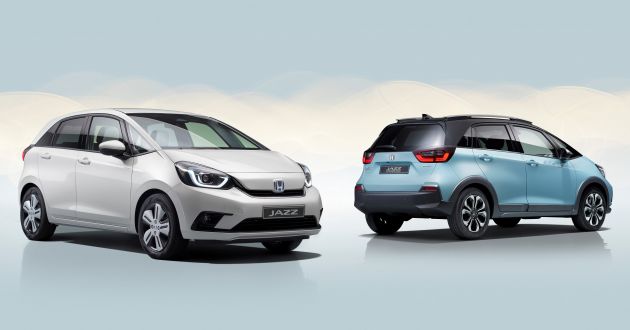At the 2019 Tokyo Motor Show, Honda revealed the fourth-generation Jazz that is available as a hybrid featuring the carmaker’s e:HEV technology. We now have more details about the hybrid powertrain, which is the only available option for the hatchback, when it arrives at European dealerships later this year in the summer.
Marketed as the Jazz e-HEV, the model will play an important role in Honda’s commitment to ensure 100% of its mainstream models sold in the continent comes with electrified powertrains by 2022. In Germany, prices start from 22,000 euros (RM99,038) for the Jazz, while the crossover-esque Crosstar variant starts from 26,250 euros (RM118,165).
The e:HEV system uses Honda’s dual-motor i-MMD (Intelligent Multi-Mode Drive) hybrid system, which replaces the previous Intelligent Dual Clutch Drive (i-DCD) setup, and is a downsized version of the Sport Hybrid i-MMD powertrain found in the Accord Hybrid and CR-V Hybrid.
On the Jazz, this sees a 1.5 litre DOHC i-VTEC four-cylinder petrol engine being paired with two electric motors, with one of them acting as a generator to recharge the lithium-ion battery. The other is an electric propulsion motor capable of spinning at speeds of up to 13,300 rpm to handle low-speed acceleration.
Rather than using a conventional transmission, the engine sends drive to the front wheels via a single fixed-gear ratio and a lock-up clutch, which is said to provide a smoother transfer of torque and a linear feel during acceleration. Honda also says this setup is also more compact and refined when compared to a planetary eCVT typically found in other hybrid vehicles.
Total output is rated at 109 PS (107 hp) and 253 Nm of torque, which propels the car from zero to 100 km/h in 9.4 seconds and a top speed of 175 km/h. Meanwhile, the system’s CO2 emissions is rated at 102 g/km and fuel economy at 4.5l/100km – both following WLTP regulations – and 110 g/km and 4.8l/100km on the Crosstar variant.
A power control unit selects from three interchangeable drive modes automatically, including EV Drive, Hybrid Drive and Engine Drive. In Hybrid Drive, excess power from the engine can also be diverted to recharge the battery via the generator motor.
EV Drive is self-explanatory, and is also engaged when the car is decelerating, harvesting energy through regenerative braking to recharge the battery. For driving at highway speeds, Engine Drive is used, with the electric propulsion motor chiming in via an on-demand “power boost” for fast acceleration.
Honda says despite the presence of the battery in the rear, the Jazz retains its Magic Seat functionality and 1,203 litres of luggage capacity with the seats down, or 298 litres with them up. Clever packaging such as positioning of the fuel tank in the centre of the chassis beneath the front seats helped in this regard.
Inside, passengers have access to an LCD touchscreen infotainment system that comes with several connected services, the Honda Personal Assistant as well as support for Android Auto and Apple CarPlay. Based on consumer demand, not all functions are hidden away in the system, with physical controls being implemented for frequently-used items like climate and media volume controls.
The Jazz also comes with ten airbags and a range of Honda Sensing safety and driver aids as standard, including the Collision Mitigation Braking System, Adaptive Cruise Control, Lane Keep Assist System and Road Departure Mitigation System. Also available is Blind Spot Information with Cross Traffic Monitor, Intelligent Speed Limiter, Auto High-Beam Headlights andTraffic Sign Recognition.
Source: Read Full Article






